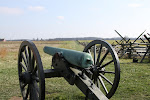The
years following the Civil War were especially hard for newly-freed slaves. With
no homes, no money, and no prospects, one can imagine the hopelessness that
came with freedom.
To
help, President Abraham Lincoln advocated for a bill to establish an organization to
assist freedmen.
On
March 3, 1865, Congress passed the Freedmen's Bureau Bill. The new agency was
created within the War Department, the only federal agency with a structure
that could be assigned in the South to assist freed slaves in obtaining relief,
land, jobs, fair treatment, and education.
 |
| Recently freed slaves meet with the Freedmen's Bureau |
The
Freedmen's Bureau arranged for schools and served as legal advocates for
African Americans in both local and national courts, mostly in cases dealing
with family issues and property issues. Assistance was also provided to help
African Americans find family members who had become separated during the war.
The Bureau encouraged former














